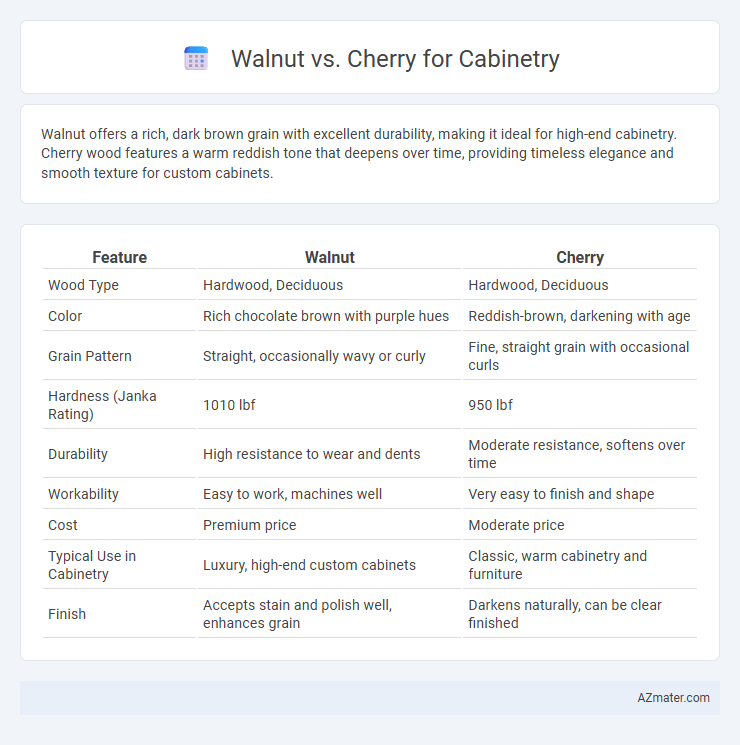Walnut offers a rich, dark brown grain with excellent durability, making it ideal for high-end cabinetry. Cherry wood features a warm reddish tone that deepens over time, providing timeless elegance and smooth texture for custom cabinets.
Table of Comparison
| Feature | Walnut | Cherry |
|---|---|---|
| Wood Type | Hardwood, Deciduous | Hardwood, Deciduous |
| Color | Rich chocolate brown with purple hues | Reddish-brown, darkening with age |
| Grain Pattern | Straight, occasionally wavy or curly | Fine, straight grain with occasional curls |
| Hardness (Janka Rating) | 1010 lbf | 950 lbf |
| Durability | High resistance to wear and dents | Moderate resistance, softens over time |
| Workability | Easy to work, machines well | Very easy to finish and shape |
| Cost | Premium price | Moderate price |
| Typical Use in Cabinetry | Luxury, high-end custom cabinets | Classic, warm cabinetry and furniture |
| Finish | Accepts stain and polish well, enhances grain | Darkens naturally, can be clear finished |
Introduction to Walnut and Cherry Wood
Walnut and cherry are highly sought-after hardwoods in cabinetry, prized for their rich color and durability. Walnut wood features a deep, chocolate-brown hue with distinctive grain patterns, offering a luxurious and timeless aesthetic. Cherry wood is known for its warm reddish-brown tone that darkens gracefully with age, providing elegance and a smooth texture perfect for fine cabinetry.
Appearance and Color Differences
Walnut cabinetry is renowned for its rich, dark brown hues with deep chocolate undertones and occasional purple or gray streaks, offering a warm and elegant aesthetic. Cherry wood displays a lighter reddish-brown color that darkens over time into a rich, warm patina, providing a classic and inviting look. The contrasting grain patterns of walnut's straight and wavy textures versus cherry's smooth, fine grain contribute to distinctive visual appeal in cabinetry design.
Grain Patterns and Texture
Walnut cabinetry features a rich, dark brown color with straight grain patterns that often display subtle waves and occasional curls, creating a smooth and consistent texture. Cherry wood offers a finer, tighter grain with a more uniform and satiny texture that darkens to a rich reddish-brown over time, enhancing its natural warmth. Both woods provide unique grain aesthetics, with walnut appealing to those seeking bold, dramatic patterns and cherry favoring a sleek, refined appearance.
Durability and Hardness Comparison
Walnut exhibits a Janka hardness rating of about 1,010, making it moderately durable with good resistance to dents and scratches for cabinetry use. Cherry, with a Janka hardness of around 950, is slightly softer but develops a rich patina over time that enhances its surface toughness. Both woods provide durable options, but walnut's higher hardness offers superior scratch resistance for high-traffic cabinetry environments.
Cost and Affordability
Walnut cabinetry commands a higher price due to its rich grain and durability, often ranging from $8 to $15 per board foot, making it a premium choice for luxury kitchens. Cherry wood offers a more affordable option, typically priced between $5 and $10 per board foot, while still providing warmth and a smooth finish. Budget-conscious homeowners often prefer cherry cabinetry for its balance of cost-effectiveness and elegant appearance without compromising on quality.
Aging and Color Changes Over Time
Walnut cabinetry darkens with age, developing a rich, deep brown hue that enhances its natural grain, while cherry wood transitions from a light pinkish tone to a warm, reddish-brown patina over time. Both hardwoods offer unique color evolution, but walnut's aging process tends to be more subtle and consistent, whereas cherry's vibrant transformation adds character and warmth to interiors. Choosing between walnut and cherry depends on the desired long-term aesthetic, with walnut providing a darker, more uniform finish and cherry delivering a dynamic, warm glow.
Workability and Finishing Qualities
Walnut offers excellent workability due to its straight grain and moderate hardness, making it easy to cut, shape, and sand for cabinetry. Cherry wood also provides good workability, though it tends to be softer and can burn more easily during machining, requiring careful handling. Both woods finish beautifully, with walnut showcasing a rich, dark patina and cherry developing a warm, reddish hue that deepens over time, enhancing cabinetry aesthetics.
Maintenance and Care Needs
Walnut cabinetry requires regular dusting and occasional oiling to maintain its rich, dark tones and prevent drying or cracking. Cherry wood darkens over time with exposure to light, necessitating careful positioning away from direct sunlight and periodic polishing to preserve its warm, reddish finish. Both woods benefit from using mild, non-abrasive cleaners and avoiding excessive moisture to prolong their durability and appearance.
Sustainability and Environmental Impact
Walnut cabinetry, sourced from durable hardwood species like Juglans nigra, offers longevity but involves slower tree regrowth rates, impacting sustainability. Cherry wood, primarily from Prunus serotina, presents faster growth cycles and better carbon sequestration potential, contributing to a reduced environmental footprint. Both materials necessitate responsible forest management and certification, such as FSC, to ensure minimal ecological disruption in cabinetry production.
Best Uses: Choosing Between Walnut and Cherry for Cabinetry
Walnut cabinetry excels in modern and upscale designs due to its rich, dark tones and durability, making it ideal for statement pieces and luxury kitchens. Cherry wood offers a warm, reddish hue that deepens over time, perfect for traditional or transitional styles seeking elegance and timeless appeal. Both woods provide excellent strength, but walnut is better suited for high-end, contemporary looks while cherry benefits spaces aiming for classic sophistication.

Infographic: Walnut vs Cherry for Cabinetry
 azmater.com
azmater.com